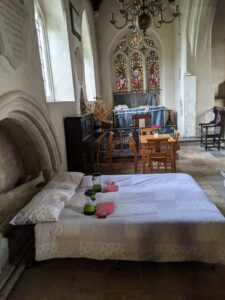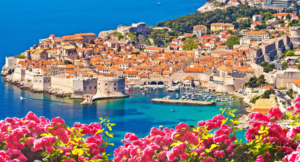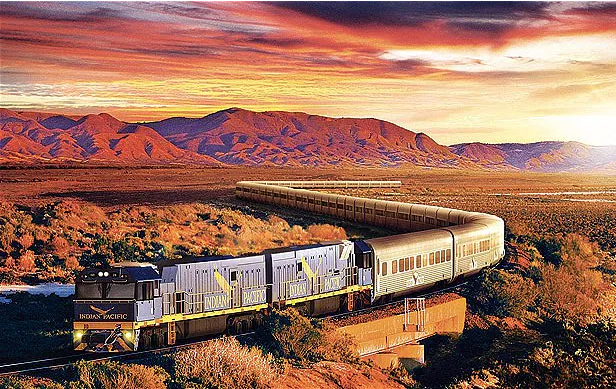
Celebrity Cruise 22nd January 2023 to 14th February 2023
The Adventure
Summary
This was a holiday of contrasts; a 12-day cruise calling in at various ports around the North and South islands of New Zealand, crossing the Tasman Sea to Sydney, then joining the Indian-Pacific Railway for the 4-day land journey from Sydney to Perth. We’ve previously travelled by air between these two east-west Australian extremities, but we’ve never had an opportunity to see and visit the vast interior. From flourishing vineyards to great goldmines, striking mountains to the barren stretch of the Nullarbor Plain, from cities of 4 million to barely populated ghost towns. The sights, sounds and cultures we encountered on this epic holiday will stay with us for ever.
Travel
Unless you really like air travel, this was probably the worst aspect of the holiday. It consisted of:
- 22nd January, transit to Gatwick and flight to Dubai (7 hours)
- 23rd January Flight from Dubai to Brisbane (13 hours)
- 24th January Flight from Brisbane to Auckland (2.5 hours)
25th January – Aukland
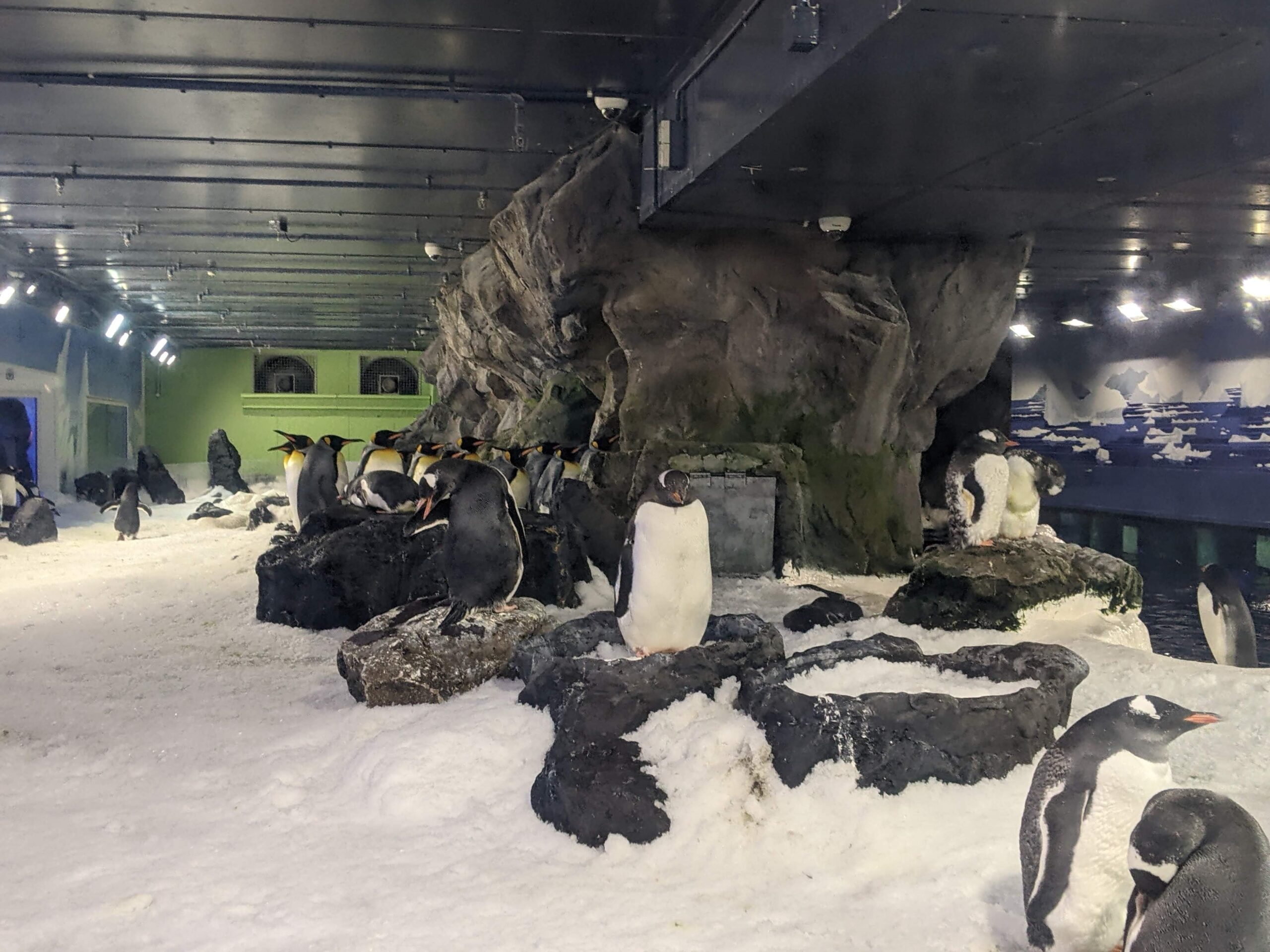
A two-night stay at the Grand Hotel. On the first day we did the ‘Hop-on-Hop-off’ bus tour which is probably the best way of seeing and getting an orientation of the city. We stopped off at Kelly Tarlton’s Sea Life, which was amazing. There were sharks, sting rays, turtles and many varieties of fish and crustaceans, all visible from an underwater viewing tunnel. But one of the best exhibits was the Sub-Antarctic penguin colony, consisting of King and Gentoo penguins. They were contained within a sealed environment that mimicked the Antarctic conditions, including real snow and a continual Arctic wind that created snow drifts. One could imagine actually being at the South Pole.
Also worth mentioning is the replica of Captain Scott’s Hut. The original can still be found perfectly preserved on the edge of the Ross Shelf on Antarctica.
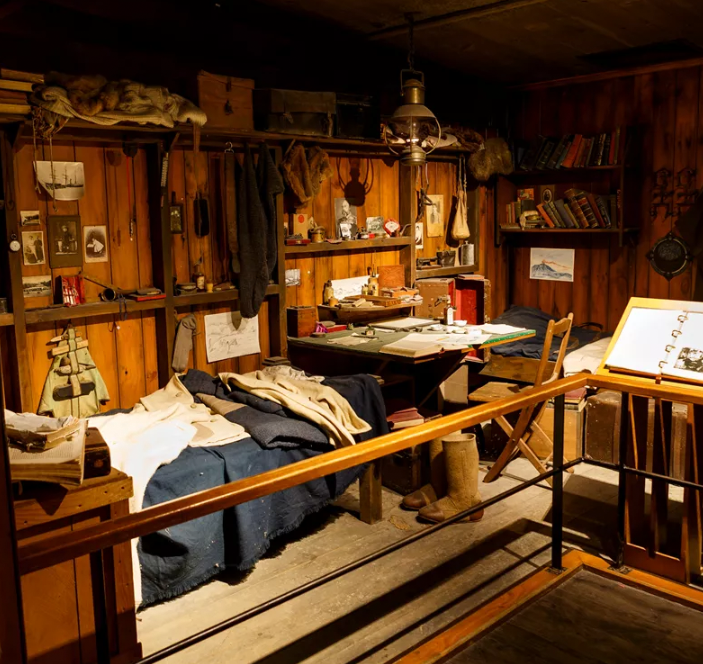
We then had lunch in one of the restaurants bordering the Wynyard Quarter, which offered views of the amazing racing yachts in the harbour. On the walk back to out hotel we stopped off at the Oyster & Chop, which was advertising a happy-hour from 3pm-6pm. Anticipating a leisurely afternoon consuming beer and oysters, it came as a bit of a surprise to us that happy hour was limited to 45 minutes (do they have Trade Descriptions Act in New Zealand?!), but we made the most of our time to enjoy good beer and the locally sourced oysters.
On the walk back to our hotel, a young and attractive girl holding some leaflets called out “do you want one?” I thought to myself, chance would be a fine thing, but I’m with my wife!
We booked an evening dinner at the Oyster & Chop, taking a risk that we would have to relinquish our table within 45 minutes, but as it happened, we were left in peace to enjoy our fish and chips!
26th January – Board Celebrity Eclipse
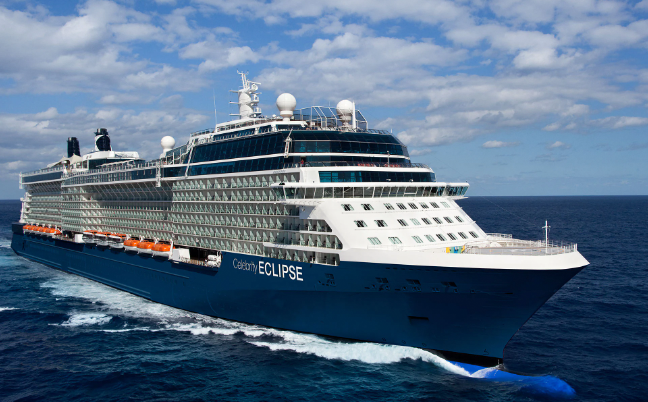
The main worry for us throughout the planning for this holiday was whether we would pass the mandatory Covid test 24-hours before we could board the Celebrity Eclipse, are home for the next 12 days. Fortunately, we did pass, but the implications of failing the test were enormous. Cancellation of the entire holiday; isolation at our own expense in Auckland for 10 days and then a flight back home. Of course, our travel insurance would reimburse us for some of the cost – but not all. Anyway, sigh of relief and we set about exploring our new home. This was the largest cruise liner we had been on, 15 decks and 2.850 passengers. However, we soon found our way around, and given there were multiple dining areas and many bars (we didn’t get round to all of them), it never once felt over-crowded.
27th January – Tauranga
Weather not too good today, drizzly rain. We visited the Tamaki Māori village which was founded in 1989 by two Māori brothers. Their entrepreneurial spirit, their love of story-telling and teaching about the old Māori ways, made the Tamaki Māori Village a truly memorable experience. When we first arrived, we had to elect a ‘chief’ representing our tour party. The villagers then performed the haka, culminating in the offer of a fern, which our chief had to pick up with his right hand, meaning our ‘tribe’ was friendly. This was followed by our chief receiving the traditional Māori greeting of a handshake and nose touching.
We learnt that the Māori word for ‘thank you’ was ‘Kia ora’, which we used a lot, given the many demonstrations we were given of Māori traditions and songs. During one of the demonstrations, some of us men were invited to learn how to do the haka. I did my best, but my rendition was more of a comedy sketch than a war dance. Oh well, I tried!
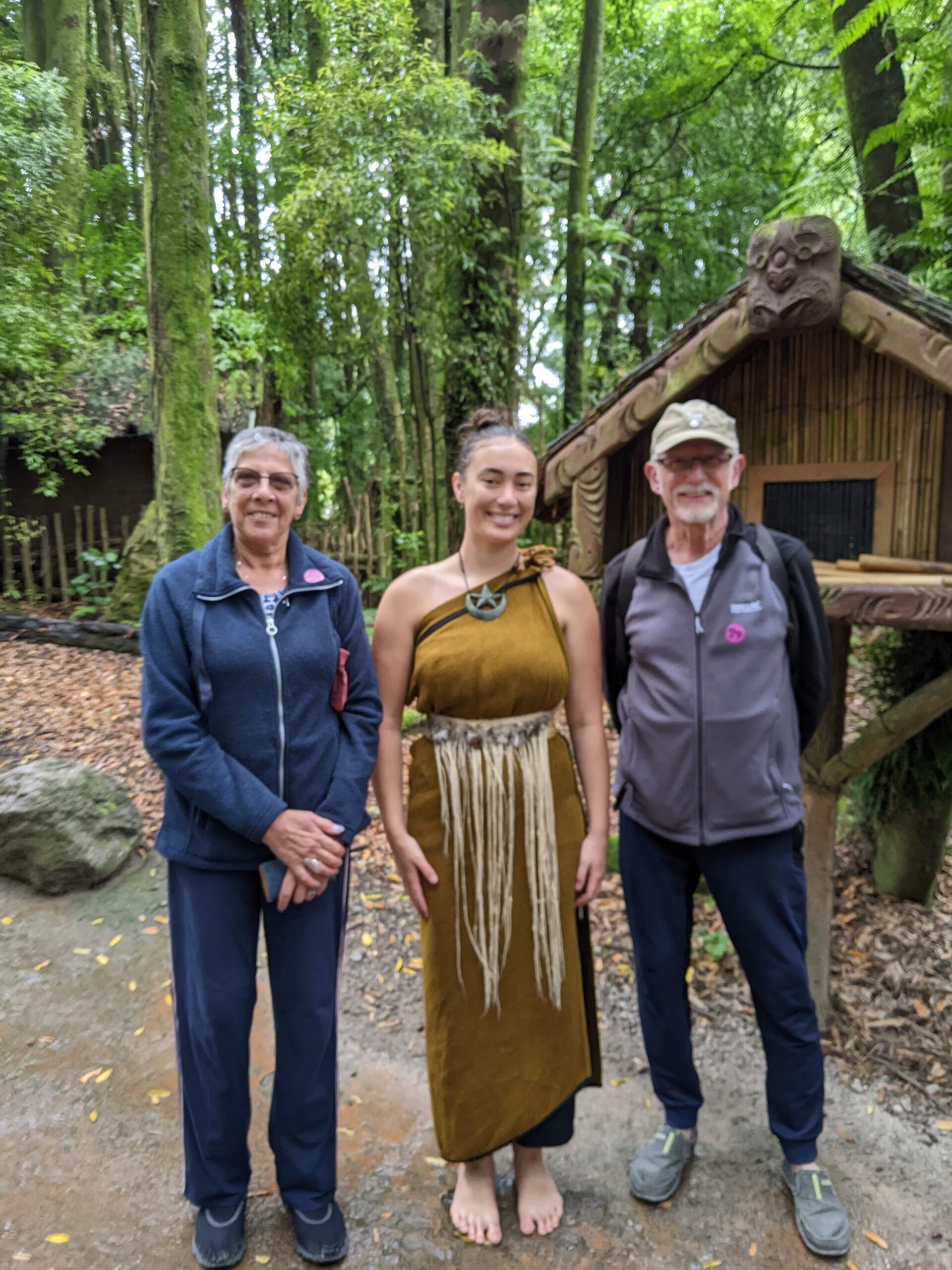
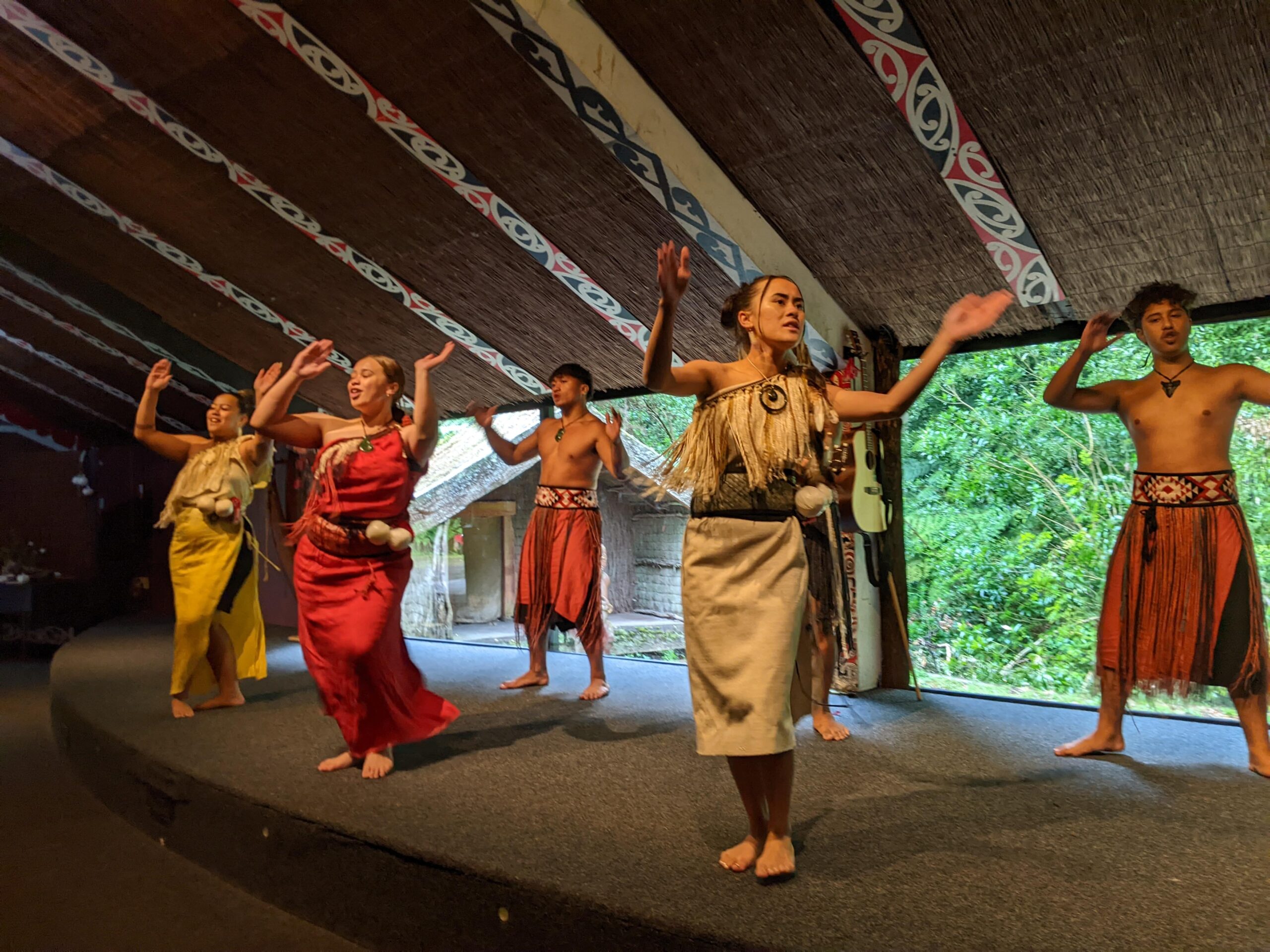
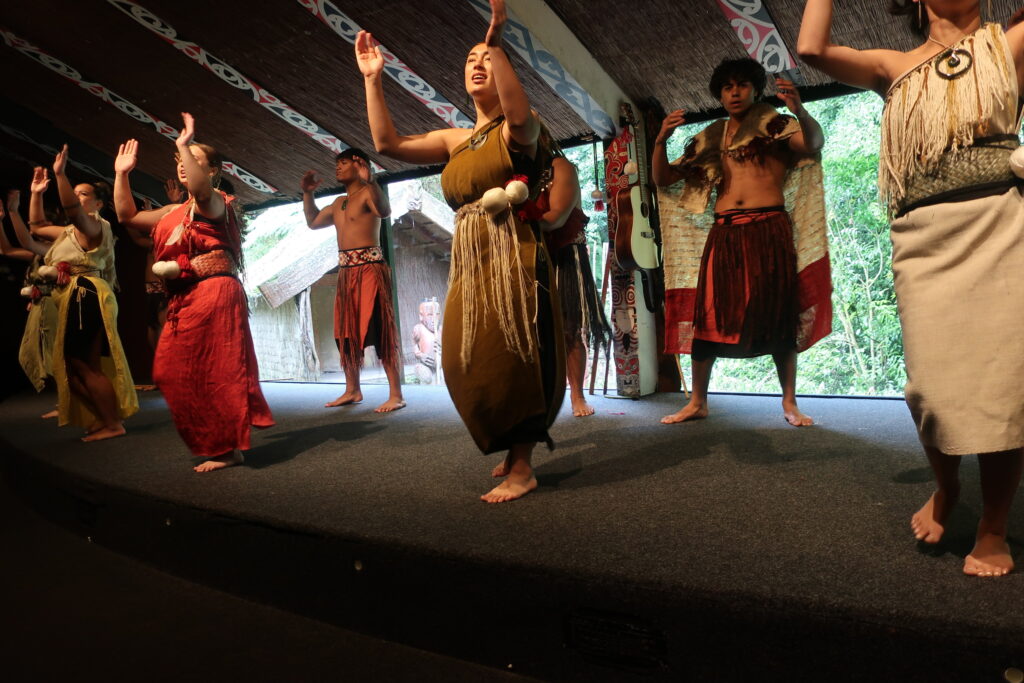
28th January – Napier
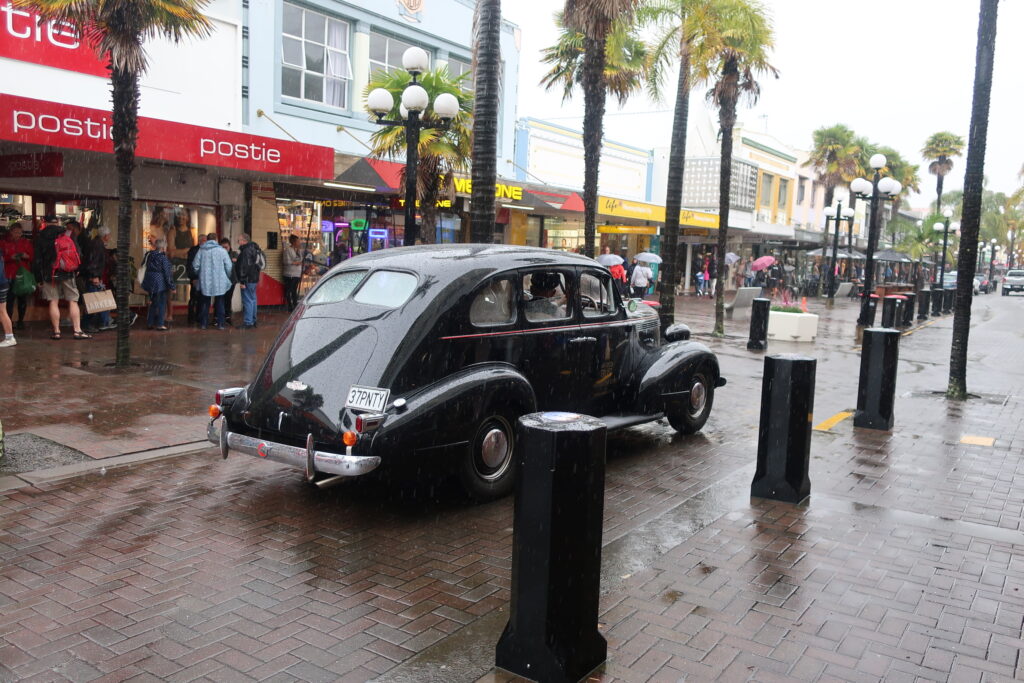
Another rainy day, but that didn’t put us off our visit to Napier, famous for its Art Deco buildings. The town was entirely rebuilt after an earthquake in 1930, and its building have been carefully preserved to this day. Napier is one of the towns in Hawke’s Bay, famous for its wine production, including cabernet sauvignon, merlot, Syrah and chardonnays. A walk down the beach promenade contains many sculptures and statues, but we didn’t really get the opportunity to see many of these because of the need to keep out of the rain
29th January – Picton
Picton is a town in the Marlborough Region of New Zealand’s South Island. The town is located near the head of the Queen Charlotte Sound. A pretty town, with limited shops, but with wild agapanthus growing everywhere.
We did the ‘Hop-on-Hop-Off’ bus to the Marlborough Wineries. Unfortunately, we couldn’t pre-book at any of the Wineries, so we opted instead to stop off at the Cork and Keg Tavern, where we had lunch and sampled several of the Marlborough wines. I particularly liked the TOHU Sauvignon Blanc – note to self: find where they sell this when back in the UK. This is also where I discovered Speights Golden Cask beer and would have been happy to consume several pints of this if I didn’t have to worry about catching the bus back to Picton!
30th January – Wellington (Capital of NZ)
We took the Cable Car, a funicular railway, between Lambton Quay, the main shopping street, and Kelburn, a suburb in the hills overlooking the central city The Cable Car has two cars, which start from opposite ends of the line and pass in the middle. They are attached to each other by a cable. Great views of the city from the Kelburn terminus, and a pleasant café from which to admire the views.
From Kelburn we did the Pukatea Bush Walk, visited the duck pond and discovered the Fairy Garden. Once back at Lambton Quay we navigated our way to Cuba Street. Lots of quirky café’s, restaurants, vintage clothing stores and art galleries, and the famous Bucket Fountain.
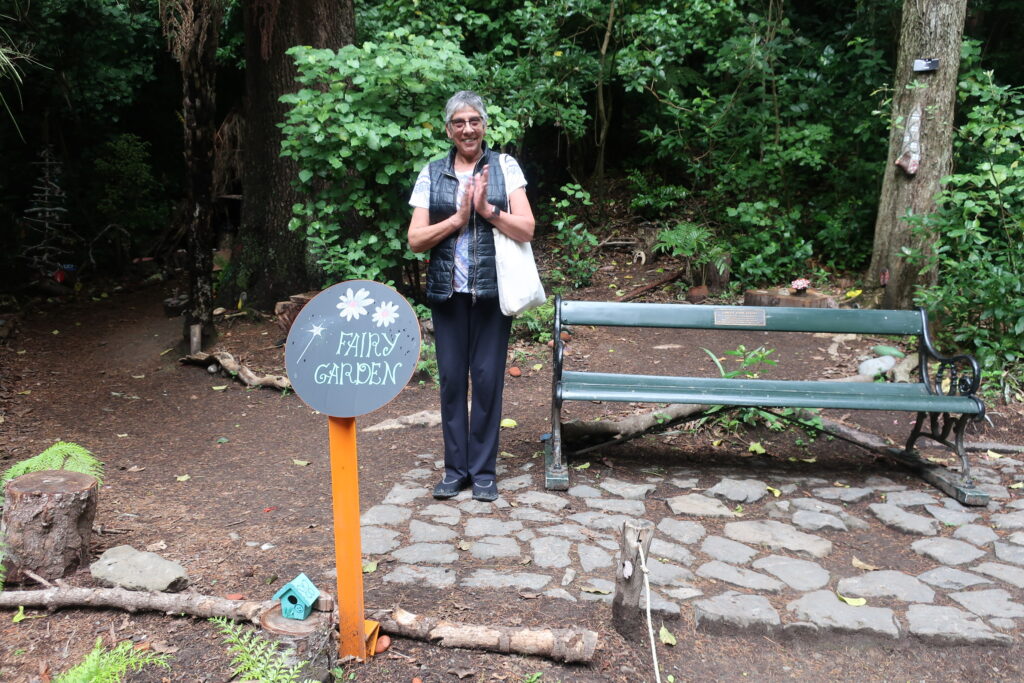
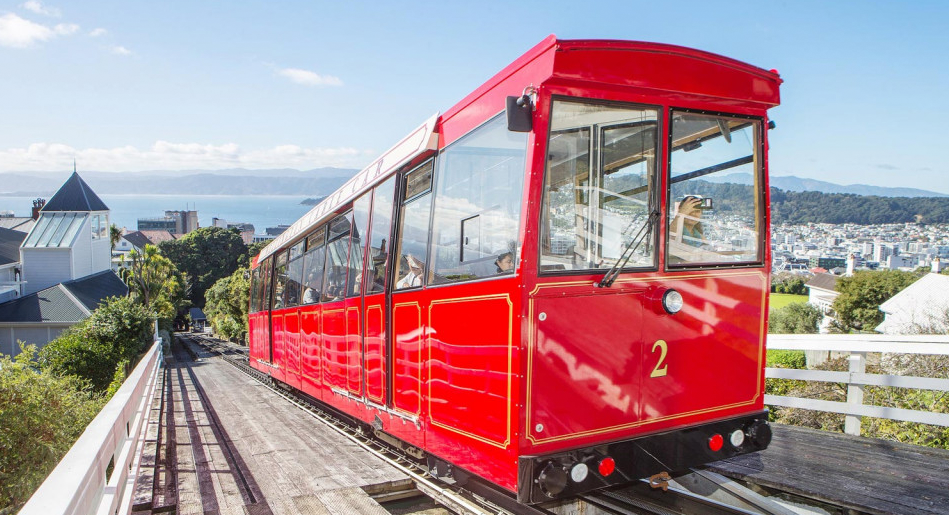
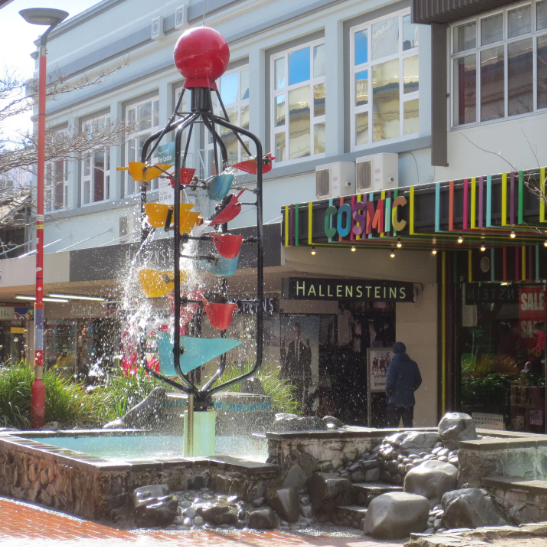
31st January – Lyttleton/Christchurch
We had booked a cruise around the picturesque Littleton Harbour. Spotted a school of dolphins that leapt playfully in the wake of our boat. Afterwards we explored the town , which mainly consisted of arts and craft shops
2nd February – Dunedin
We started from the Octagon and City Hub, walked the length of George St and North St to Baldwin St, the steepest street in the world. Walked (or climbed) to the top of Baldwin St. We met ‘Dave’ who lives locally and holds the record for the fasted time for running up Baldwin Street. Lynda has a certificate to show that she walked to the top of Baldwin street and back, should anyone doubt it!
We descended Baldwin Street and headed for the Botanical Gardens. Took a ride on the little train around the garden then walked back to the Octagon and had a well-earned drink, Speights Gold for me, wine for Lynda. Then back to the ship via the Shuttle Bus.
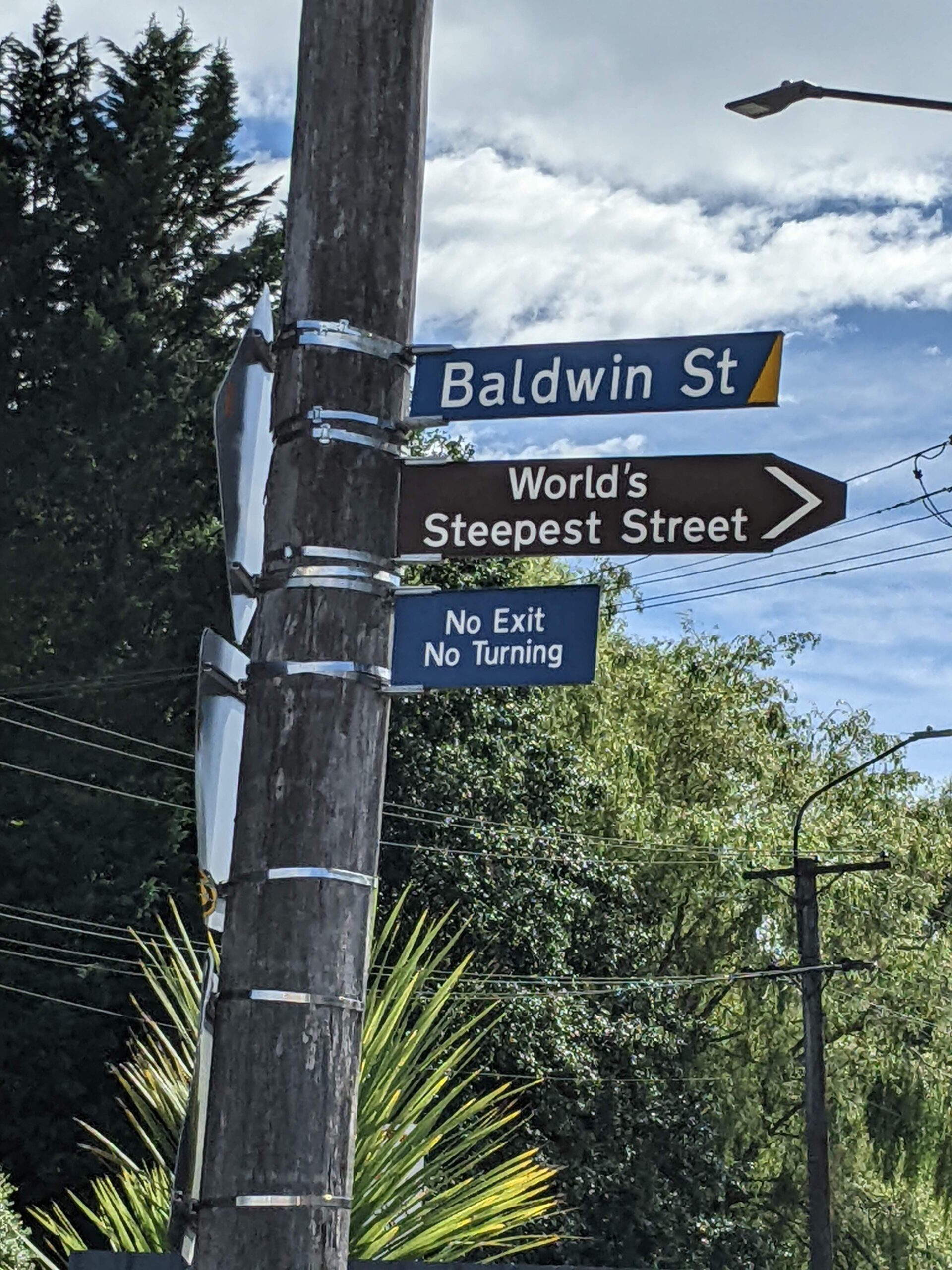
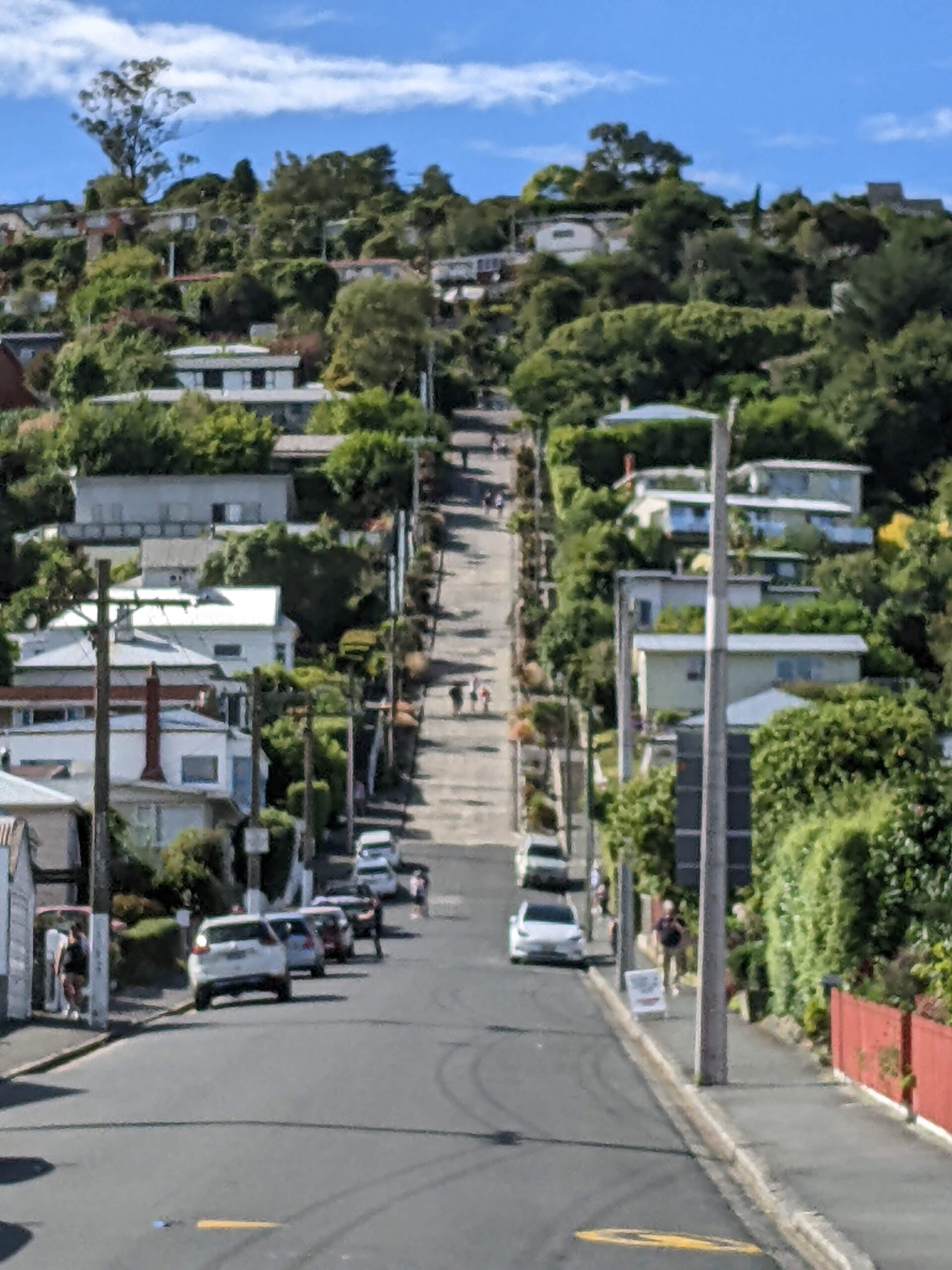
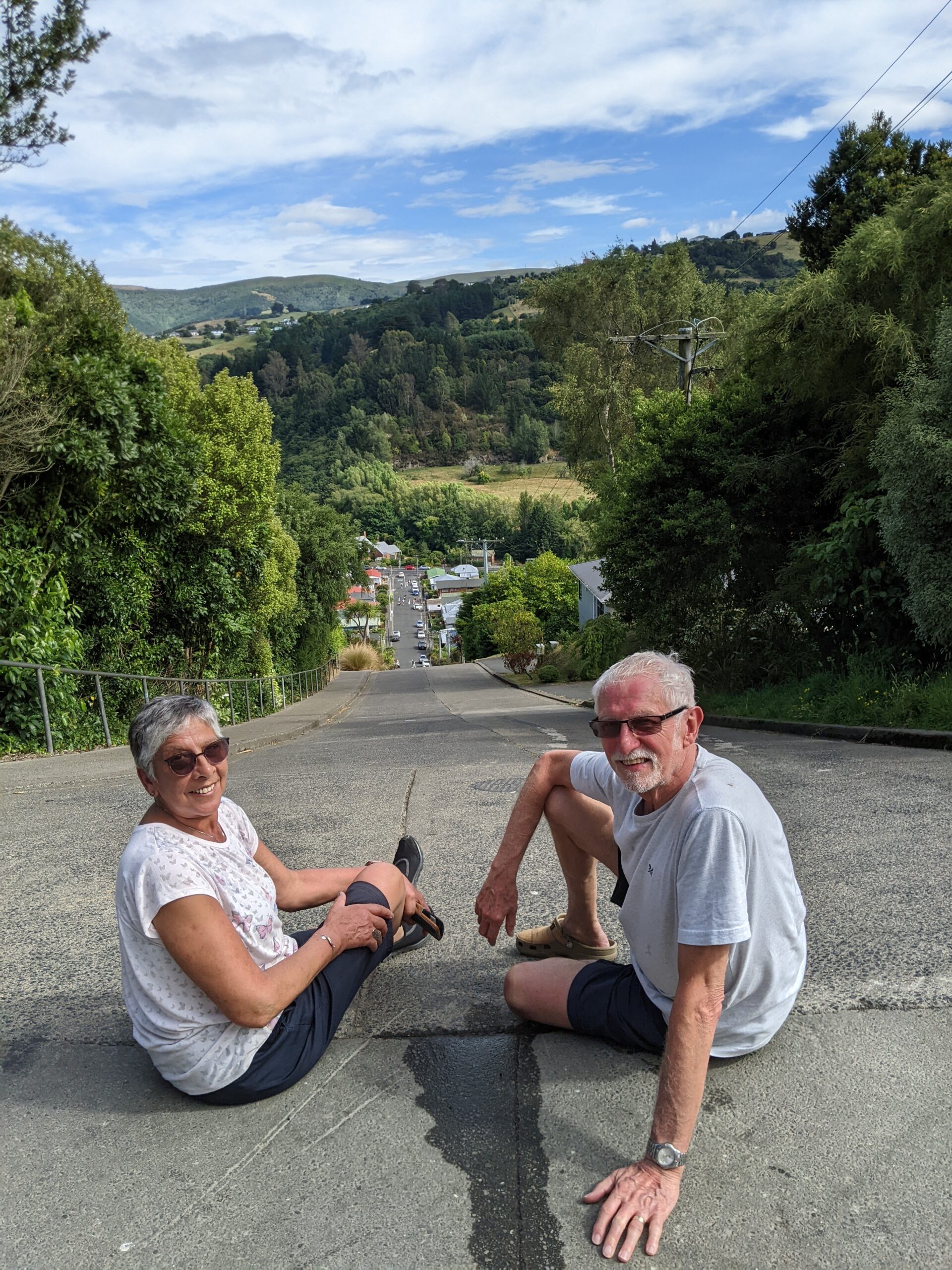
3rd February – Dusky Sound, Doubtful Sound, Milford Sound
Dusky Sound
A wildlife paradise, famous for the Fiordland Penguins. Also seals, dolphins, broad billed prions, mottled petrels and sooty shear waters.
Doubtful Sound
Very peaceful. Cold mountain water flowing from the cliffs creates an unusual phenomenon, a dual layered marine ecosystem of fresh and salt water. Fur seals and two types of penguins – the Fiordland crested and blue penguin.
Milford Sound
Narrow fiords, with cliffs climbing up either side of the ship. Situated within Fiordland National Park and part of the Te Wahipounamu World Heritage Site. Protected by its natural geography, a haven for all types of wildlife.
After navigating each of the Sounds we headed out into the Tasman Sea on our way to Sydney.
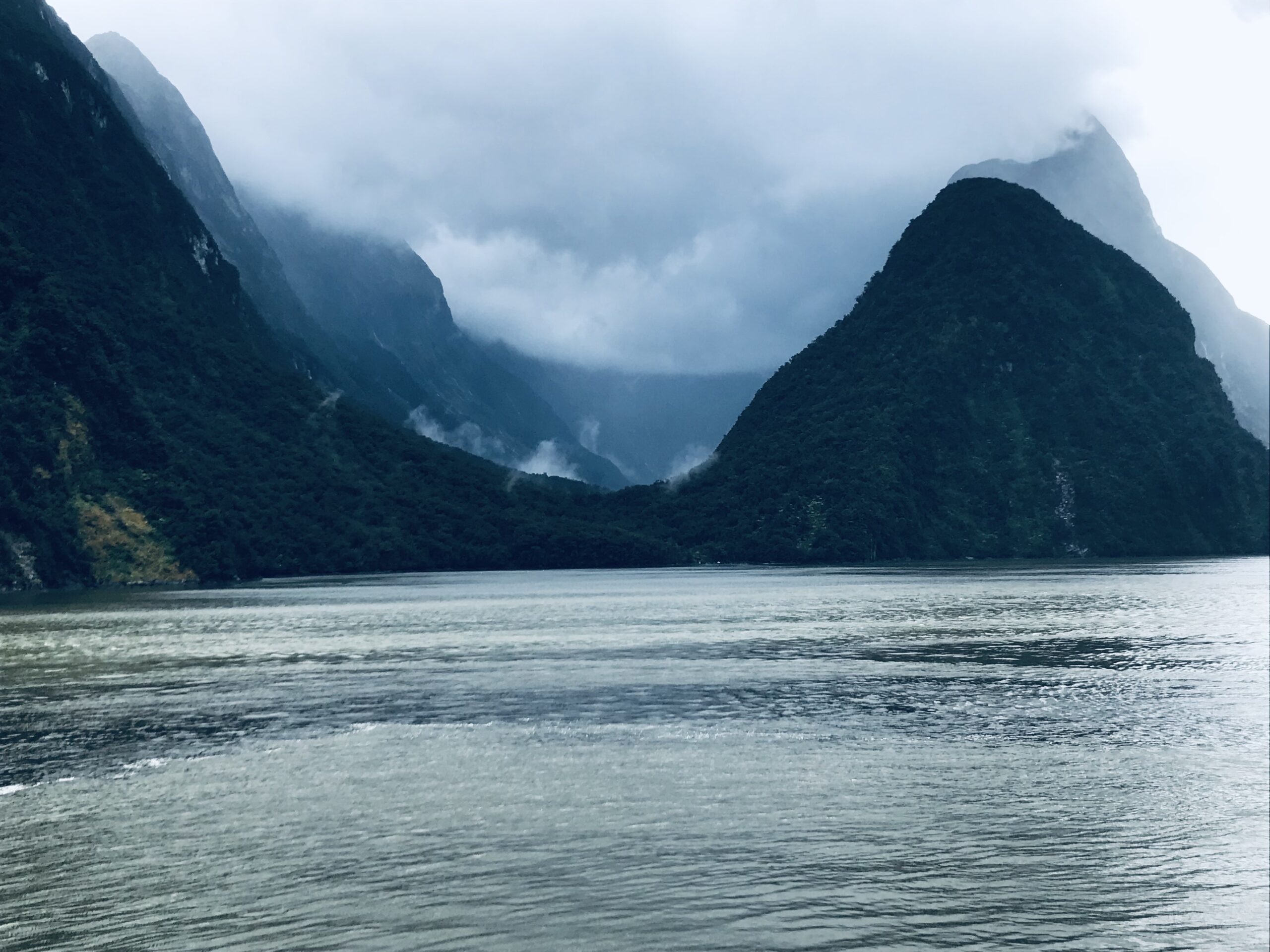
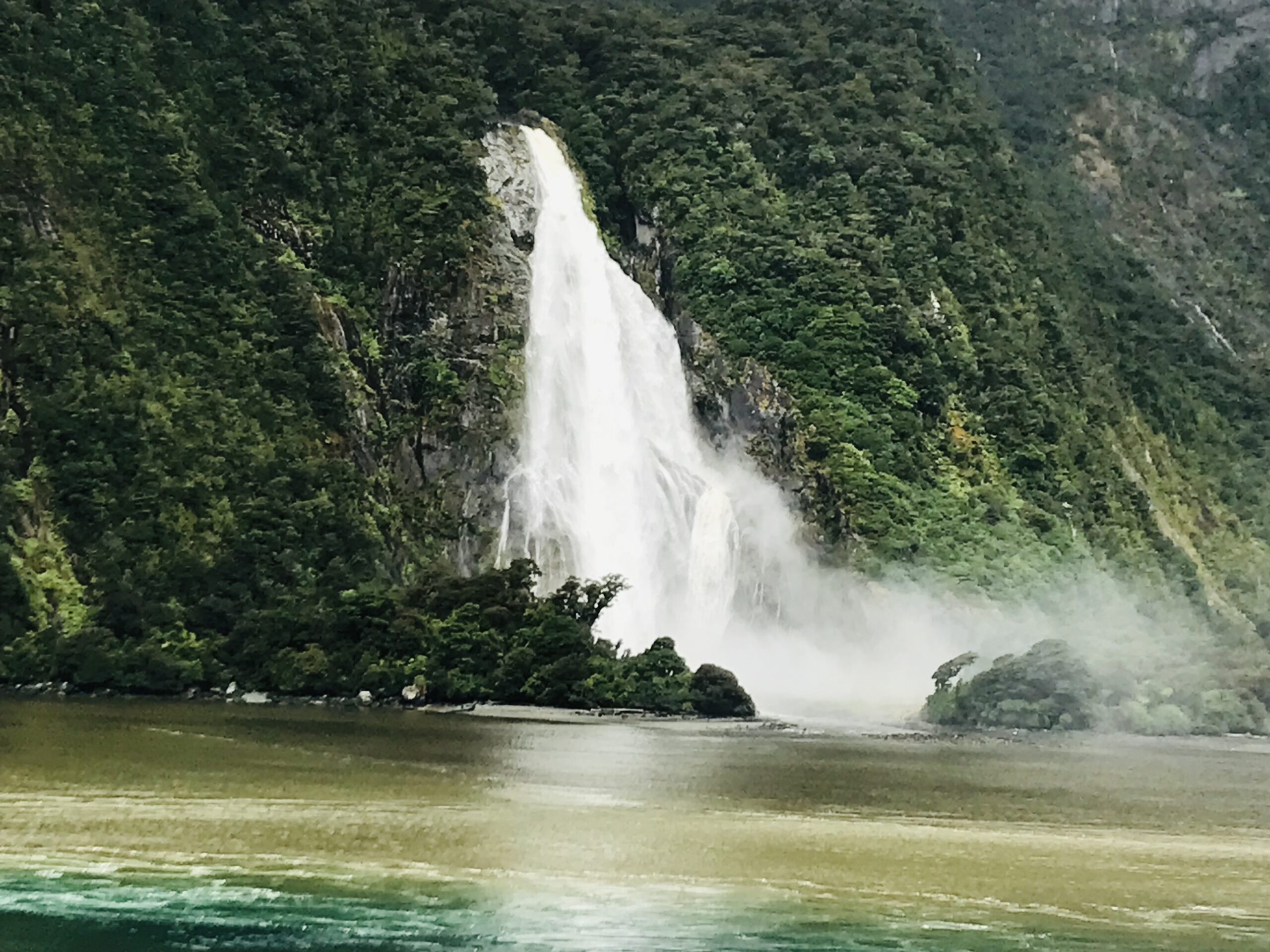
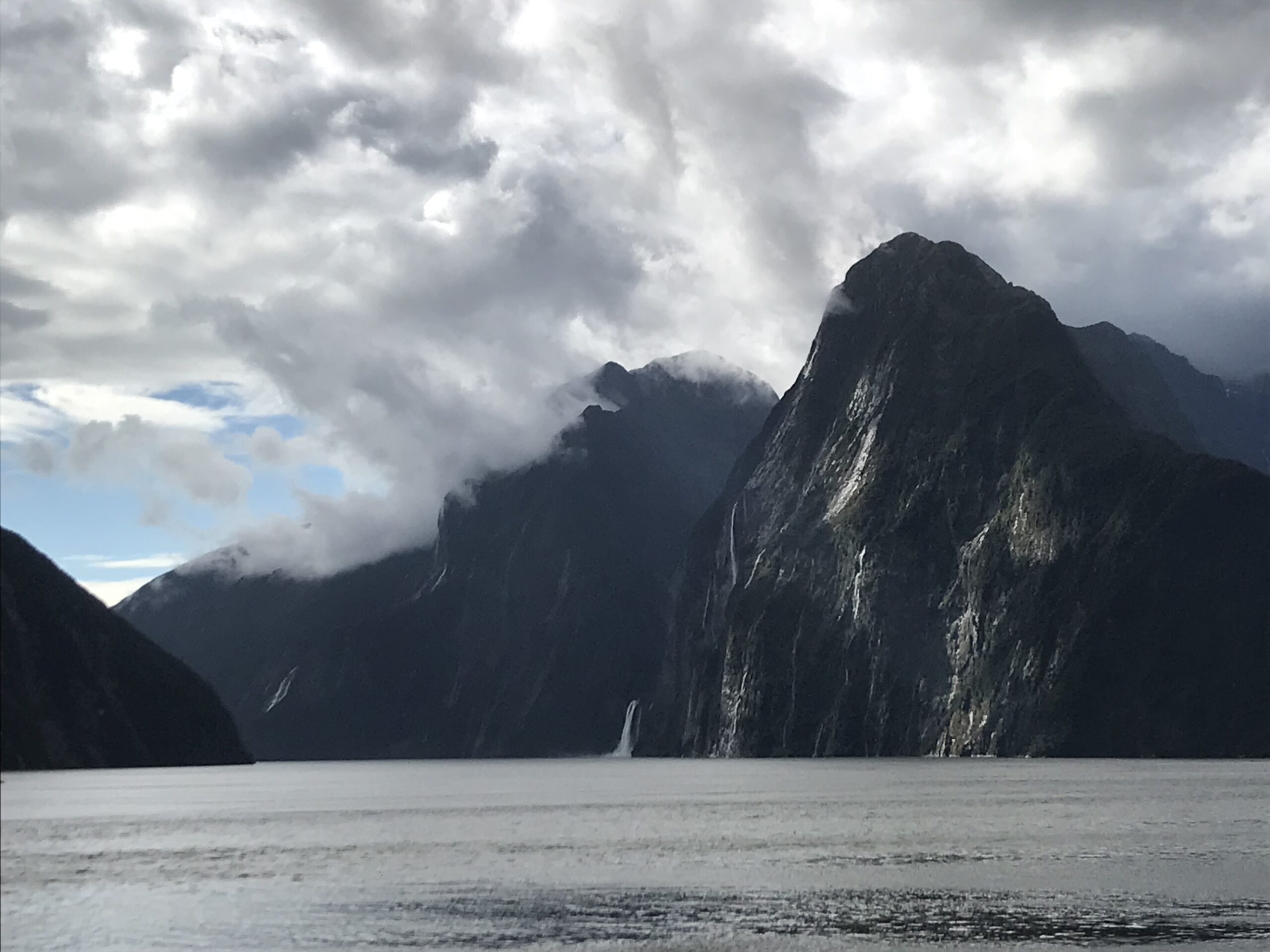
6th February – Sydney
We disembarked Celebrity Eclipse for the last time, along with many other passengers, and anxiously waited for our driver to take us to the Rydges World Square hotel. Once unpacked, we headed out to the Rocks. This area of Sydney is the strip of land where European settlers chose to step ashore in 1788 and is recognised as the birthplace of modern Sydney. It has a colourful history, and evolved from a rowdy, raucous settlement of convicts, soldiers, sailors and street gangs into a thriving, modern precinct. We had an alfresco lunch and then found a pub. Beer for me and wine for Lynda.
Afterwards we walked to the Botanic Gardens, which overlooks the famous Sydney Opera House, then visited a museum where we learnt about life for the early colonists in Sydney. In the evening we walked to Cockle Bay Wharf (adjacent to Darling Harbour) and had the most amazing seafood dinner at “Nick’s”. So much seafood neither Lynda nor me could quite finish it. However, a memorable evening with good food and good company.
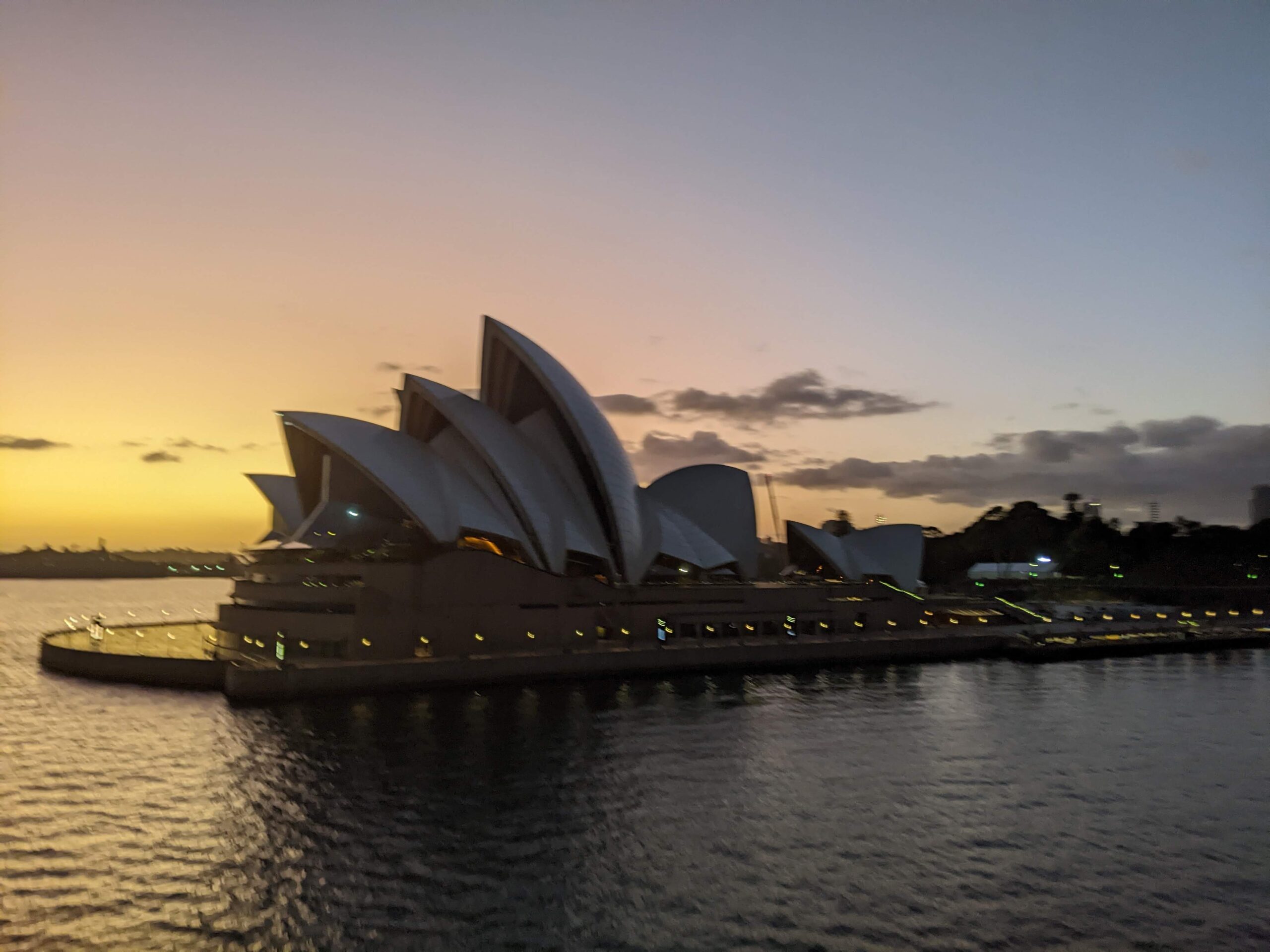
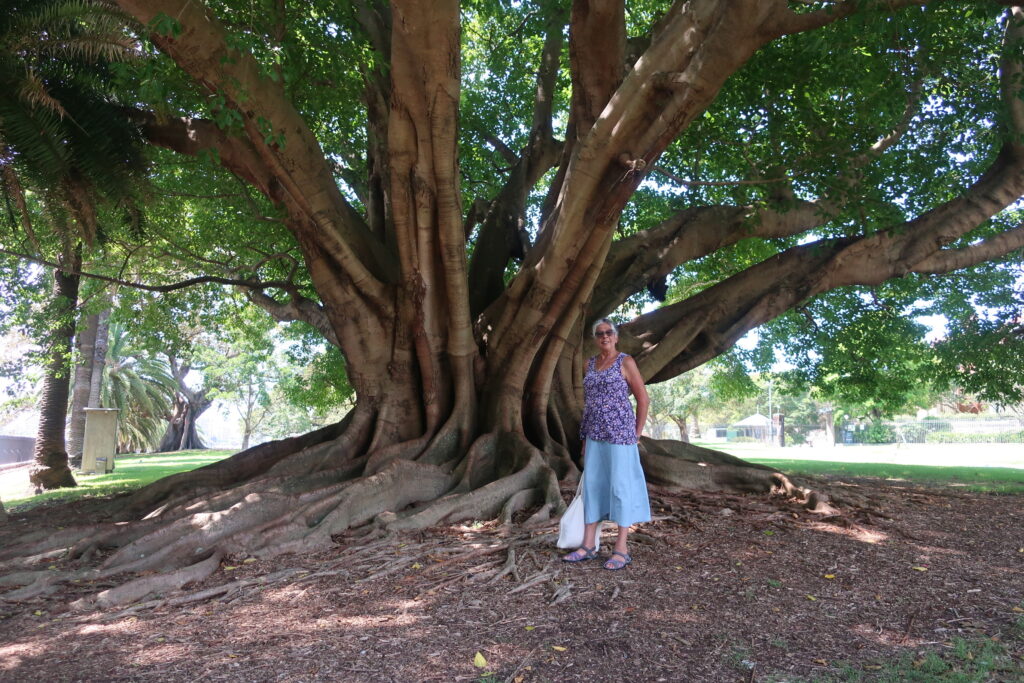
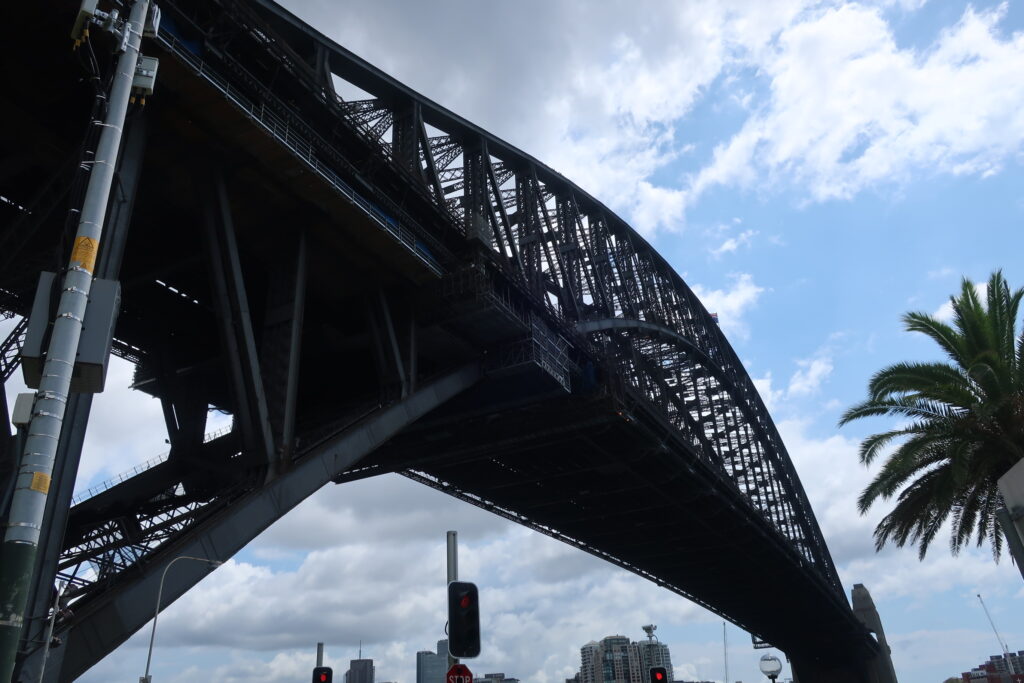
8th February – Indian-Pacific Railway
8th February Indian Pacific Railway, Broken Hill
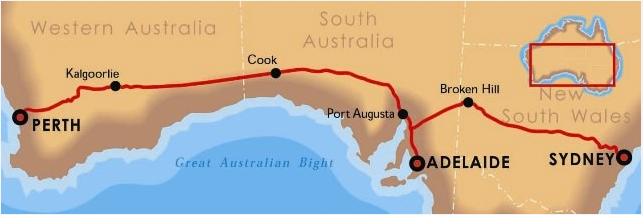
Transport from our hotel to Sydney Railway Station. Our first glimpse of the Indian-Pacific Express, which would be our home for the next 4 days. The carriages were spread across 3 different platforms because of the length of the train. Once everyone had boarded the train was re-assembled outside of the Station from the 3 platforms. We boarded at 14.19 and after a brief introduction from our hosts on the Lounge carriage, we settled into our compartment, Gold Room C2.
We started our journey, passing over Sydney’s Blue Mountains and on our way to Broken Hill.

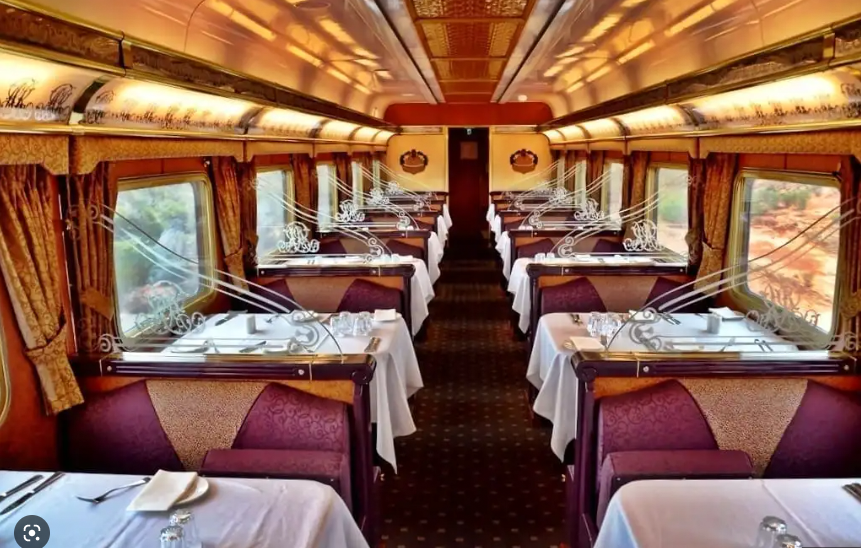
9th February Indian-Pacific Railway, Adelaide
Slow and bumpy progress overnight progress due to poor condition of the tracks cause by flooding. We stopped briefly at Broken Hill, which was a scheduled stop, but couldn’t disembark because, we were told, we needed to catch up with our schedule. Continuing the journey to Adelaide. Lots of kangaroo and emu sightings. We disembarked at Two Welles. Originally the wells were natural and permanent waterholes. In the 1880s the wells were deepened and strengthened to facilitate regular use by travelling stock. We boarded a coach for a visit to the Barossa valley, and wine tasting and lunch at Seppeltsfield, one of the wineries. The Barossa valley is famous for Shiraz, Cabernet Sauvignon and Grenache Shiraz. It was a wonderful 3-course lunch, prepared by the resident chef who has trained and worked with Marco-Pierre White. After the wine tour we were bussed to Adelaide where we rejoined the train.
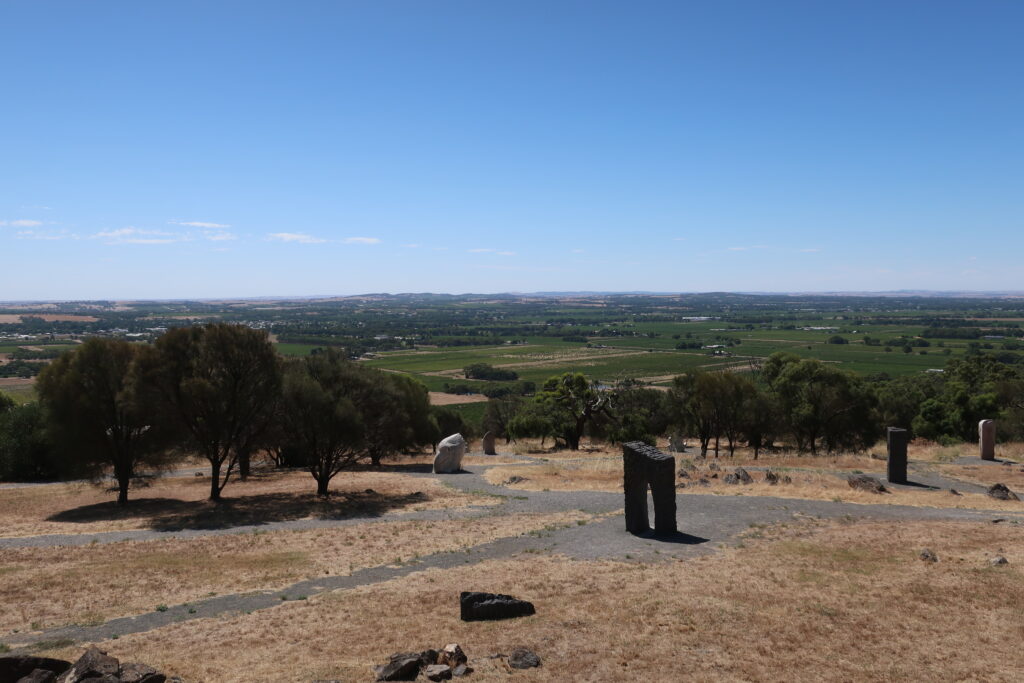
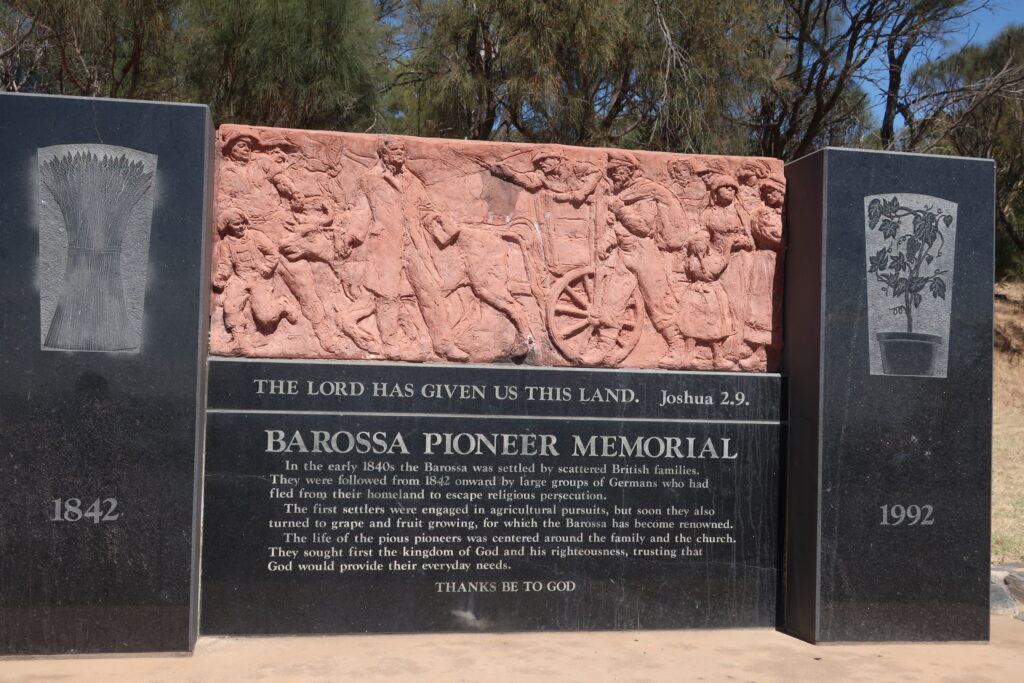
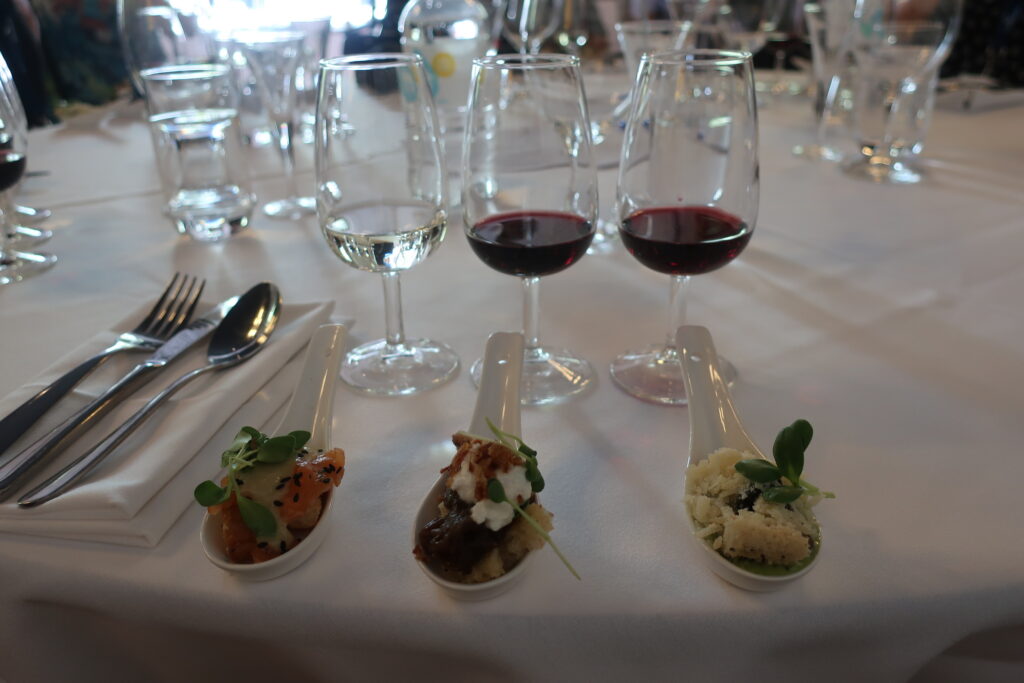
10th February Indian Pacific Railway, Cook and the Nullarbor Plain
Stopped and disembarked at the remote and largely deserted town of Cook. Cook was established in 1917 on the Nullarbor Plain when the Trans-Australian Railway was built. The town was once a major centre for track maintenance and locomotive and rolling stock repairs, it supported a school and hospital. At that time, railway employees and their families depended on two weekly provisions trains for the delivery of supplies. In 2009, Cook was said to have a resident population of four. The town was effectively closed in 1997. The reliability of diesel locomotives and the introduction of concrete sleepers and continuously welded rail rendered resident employees redundant. Track and facilities maintenance is undertaken by contractors and diesel refuelling facilities remain.
Wandered around the town, which was eerily deserted except for passengers who had disembarked the train. Visited the school, which still had some of the children’s lessons on the blackboards. Much evidence of past lives and a past community, surrounded by desert. Stopped at Rawlinna for an evening dinner under the stars. Rawlinna is a remote town 5 hours from the nearest big town of Kalgoorlie and about 900 kilometres (560 miles) east of Perth. It is on the Nullarbor Plain. A wonderful way to celebrate our final evening with the Indian-Pacific express passengers and staff.
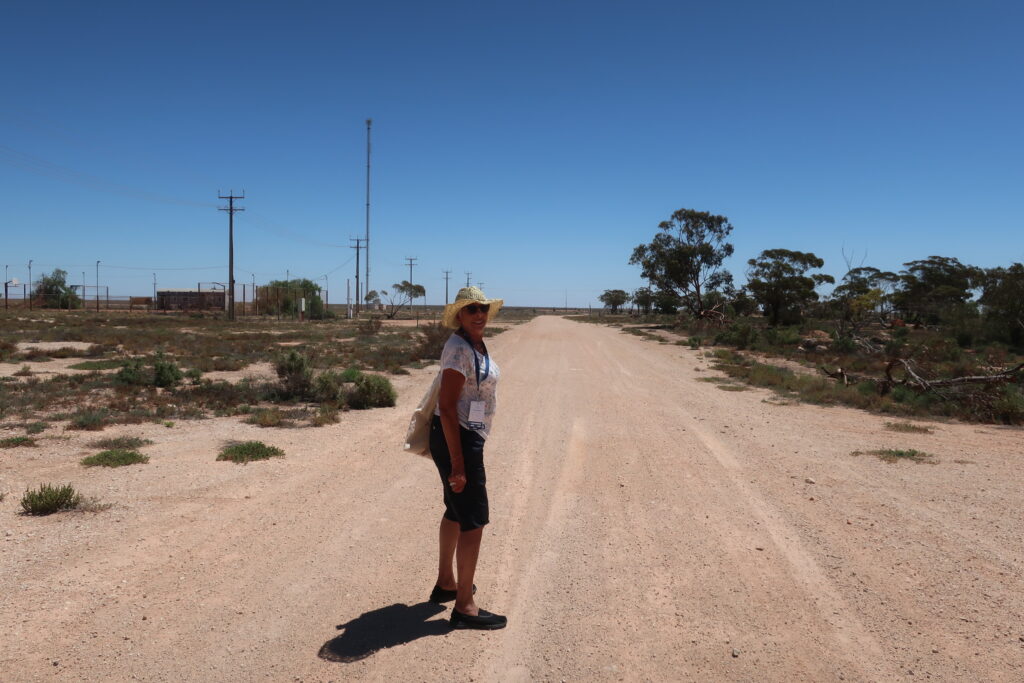
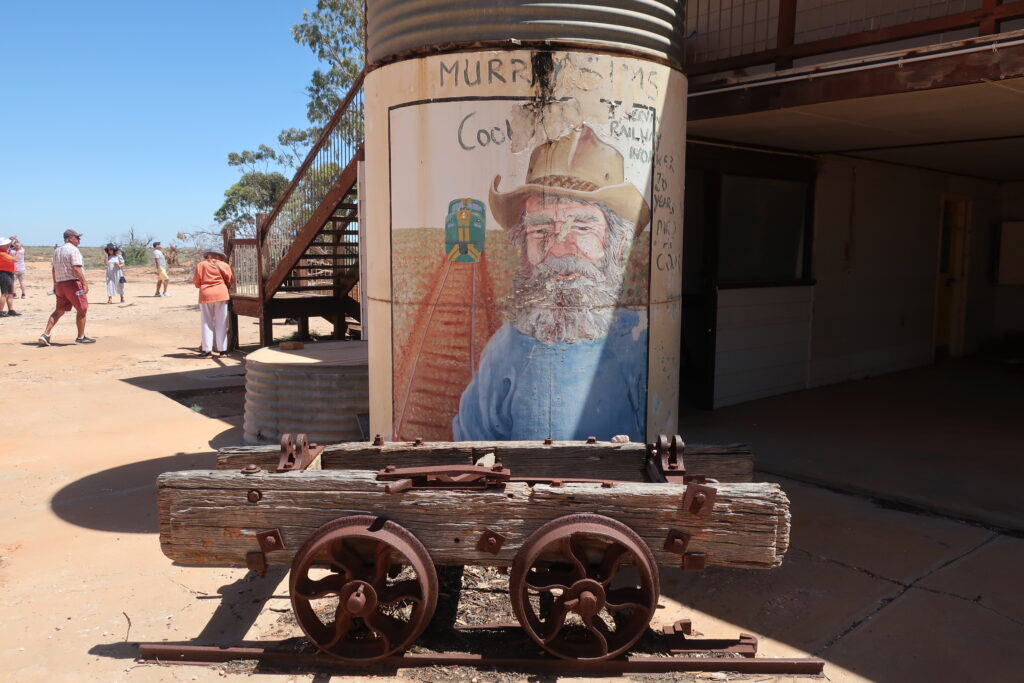
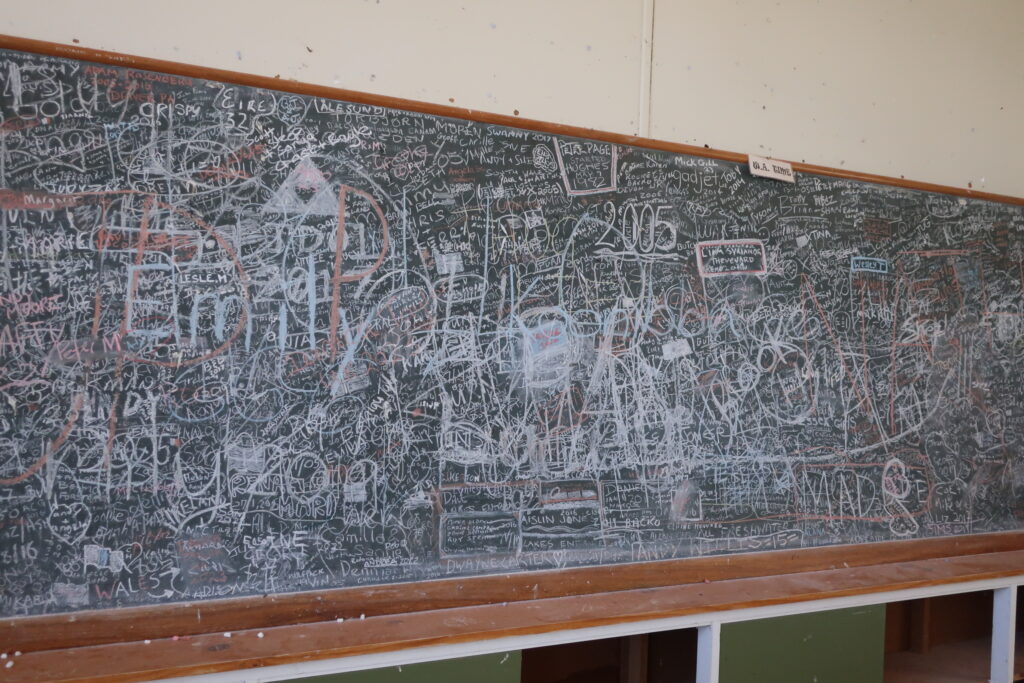
11th February Indian Pacific Railway, Perth
Arrived at Perth, a journey of 4,352 km (2,704 miles) from our starting point in Sydney. Disembarked the train and was transported to our hotel, the Pan Pacific. We Booked an excursion to Rottnest for tomorrow. Wandered around Elizabeth Key looking for somewhere to eat, but everywhere booked. Finally found an Italian restaurant not far from our hotel and had a pizza.
12th February, Perth & Rottnest
We Took the ferry from Barrack St to Rottnest Island, 19km off the coast of Fremantle. The Noongar name for the island is Wadjemup and it holds a deep cultural connection to the Traditional Owners of the island, the Wadjemup Noongar people. From 1838 to 1931, Rottnest Island was used as a prison and forced labour camp for over 3,600 Aboriginal people, who were subjected to extremely harsh conditions on the island. At least 373 people died and were buried in unmarked graves on the island. It is the largest known deaths in custody gravesite in Australia. We visited one such site, which is now a protected burial ground.
The island is now very commercialised holiday destination, similar in concept to our own (UK’s) Centre Parks, with hotels, chalets, camping, restaurants, bike and boat/canoe hire. There are white sandy beaches and a crystal-clear sea.
The indigenous wildlife includes ‘Quokkas’, a marsupial animal that does not have any predators and consequently unafraid of humans. indigenous to the island. Before leaving to catch the ferry back to Perth, we went for a swim in the warm, clear waters of Pinky Bay, a short walk from the ferry pier. Our last sample of hot weather, sea and sand before we head back Blighty.
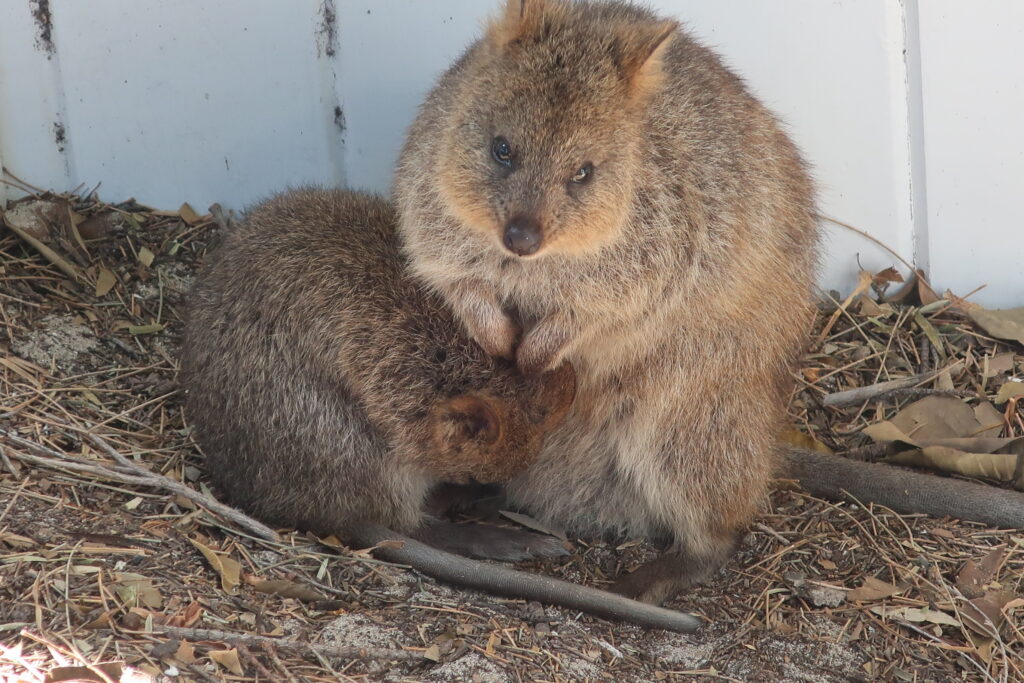

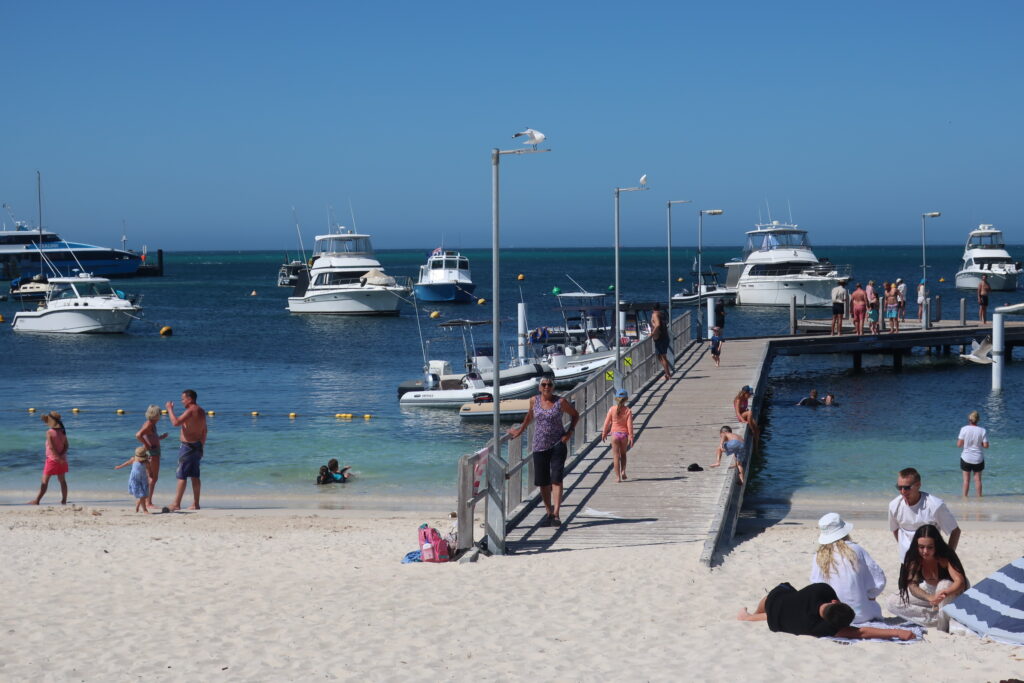
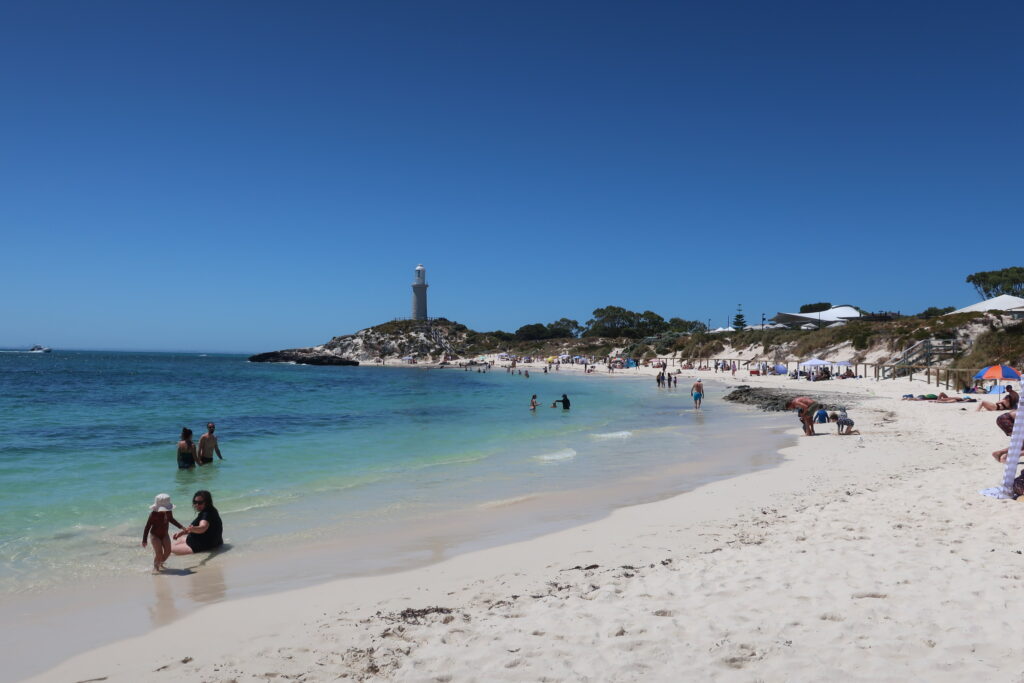
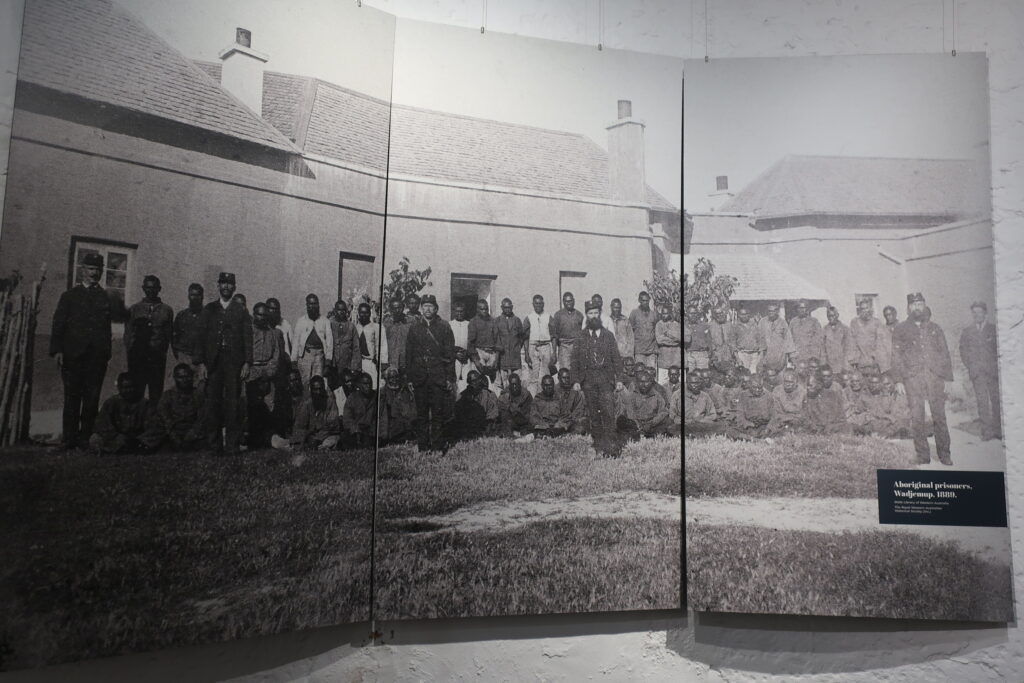
13th February, Perth, our last day
We went for a long walk in Kings Park, which skirts the Swan River and in the evening, we headed for the Quays for our last dinner before we headed back to our hotel and transport to the airport for our long (and tedious) flight home. Enough time to reflect on the holiday of a lifetime and wondering if we would ever be able to come back. Wishful thinking!
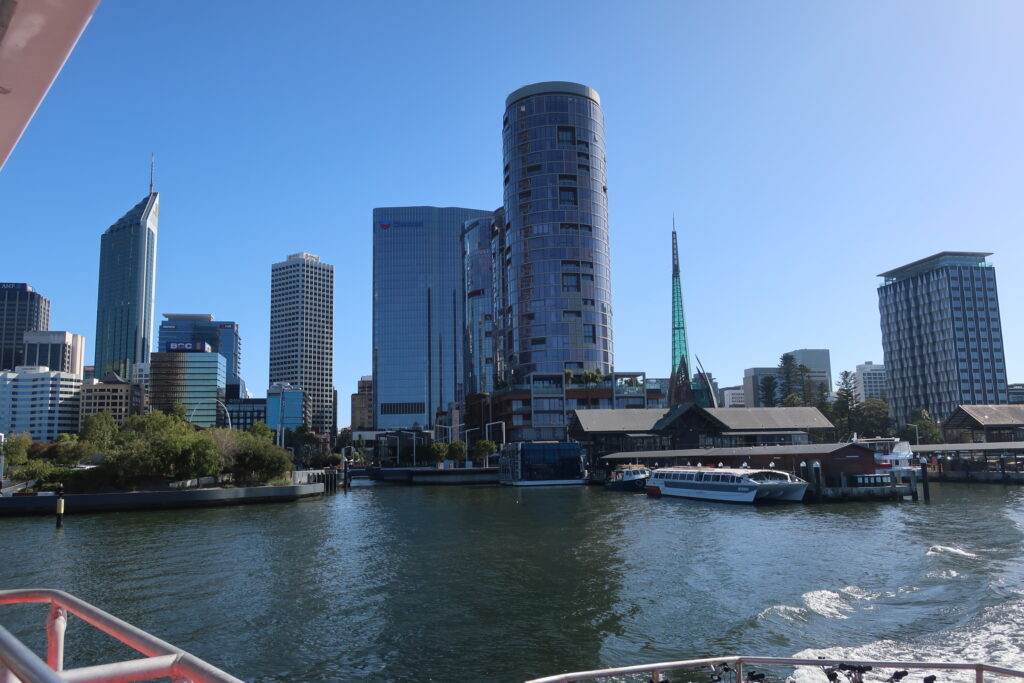
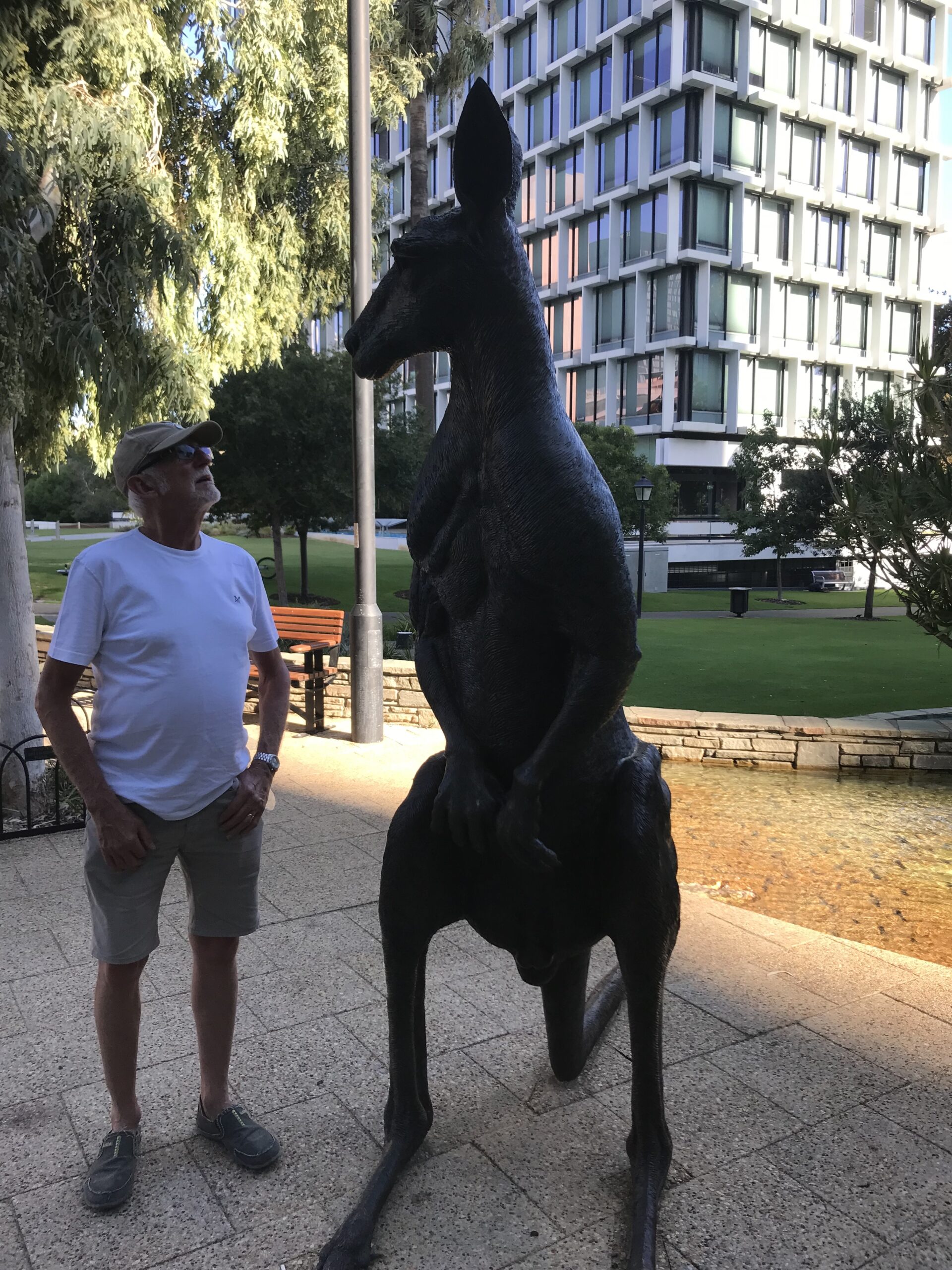
14th February, Home
Good to be home? Maybe, but also a longing to start the whole holiday again. We can hope.
